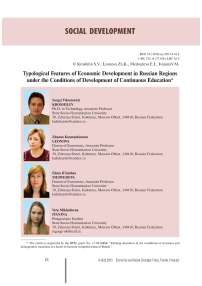Typological features of economic development in Russian regions under the conditions of development of continuous education
Автор: Kroshilin Sergei Viktorovich, Leonova Zhanna Konstantinovna, Medvedeva Elena Ilinichna, Ivanina Vera Mikhailovna
Журнал: Economic and Social Changes: Facts, Trends, Forecast @volnc-esc-en
Рубрика: Social development
Статья в выпуске: 6 (42) т.8, 2015 года.
Бесплатный доступ
In the modern conditions the socio-economic paradigm is changing, on the one hand, due to the transition to knowledge economy and, on the other hand, due to the need to develop innovation that determine competitiveness and the development level of national economies in the world. It is obvious that the progressive upgrade and the improvement of production processes (change in technological modes) can not be implemented without the increase in the level of human capital in the society and the enhancement of potential and qualification of the workforce. These changes largely depend on the education system. In almost all world countries there is an active process of modernization and change in the system of training. New forms and approaches appear, for example lifelong education (concept “Lifelong education”), informal forms of learning, self-education, etc. Without the development of these approaches it is not possible to become a competitive state in changing social, political and economic environment...
Typology of regions, lifelong learning, economic development of regions, classification of regions, socio-economic development of regions
Короткий адрес: https://sciup.org/147223793
IDR: 147223793 | DOI: 10.15838/esc/2015.6.42.4
Список литературы Typological features of economic development in Russian regions under the conditions of development of continuous education
- Inozemtsev V. Nametivshiesya vosproizvodstvennye tendentsii mirovogo khozyaistva . Ekonomist , 2000, no. 6, p. 80.
- Kroshilin S.V., Leonova Zh.K., Medvedeva E.I. Vostrebovannost' obrazovatel'nykh uslug kontragentami rynka . Kolomna: MGOSGI, 2015, p. 154.
- Leonova Zh.K. Osobennosti primeneniya gosudarstvenno-chastnogo partnerstva v sfere obrazovaniya// Stsenarii razvitiya sotsial'noi sfery v usloviyakh novykh vyzovov: materialy Vserossiiskoi nauchno-prakticheskoi konferentsii, 27 noyabrya 2014 g. . Under editorship of Professor E.V. Egorov, P.N. Lomanov, T.B. Belyaev. Moscow: Kreativnaya ekonomika, 2014, p. 56.
- Man'ko N.N. Gosudarstvo, biznes i nauka. Osnovy vzaimodeistviya . Sovremennaya nauka. Seriya “Ekonomika i parvo” , 2012, no. 5-6. Available at: http://www.vipstd.ru/nauteh/index.php/-ep12-05/516-a
- Rawls J. Teoriya spravedlivosti . Novosibirsk: Izd-vo Novosibirskogo un-ta, 1995, p. 125.
- World Bank Annual Report 2015. Available at: http://documents.vsemirnyjbank.org/curated/ru/2015/10/25109422/world-bank-annual-report-2015
- North D. Instituty, institutsional'nye izmeneniya i funktsionirovanie ekonomiki . Moscow: Nachala, 1997.
- Lapaev S.P. Tipologizatsiya regionov Rossii: innovatsionnyi podkhod . Vestnik Orenburgskogo gosudarstvennogo universiteta , 2014, no. 8 (169), pp. 100-105.
- Granberg A.G. Regional'noe razvitie: opyt Rossii i Evropeiskogo Soyuza . Moscow: RGB, 2007.
- Mottaeva A.B. Analiz tipologii regionov dlya tselei postroeniya politiki ustoichivogo razvitiya Rossii . Naukovedenie , 2014, no. 4 (23). July-August. Available at: http:// href='contents.asp?titleid=7912' title='Науковедение'>Naukovedenie.ru/PDF/131EVN414.pdf
- Kriulina E.N., Kononenko A.A. Tipologiya regionov: investitsionnyi potentsial . Stavropol': Stavropol'skii gosudarstvennyi universitet, 2015. Available at: http://stgau.ru/company/personal/user/12117/files/lib/B2.pdf
- Reiting stran mira po urovnyu obrazovaniya 2015 . Proekt Global-edu Tsentra intensivnykh tekhnologii obrazovaniya , 2015. Available at: http://global-edu.ru/foreign-education/education-country-ratings/
- World Development Indicators 2014. The Word Bank. Documents and Reports. Available at: http://documents.vsemirnyjbank.org/curated/ru/2014/05/19485574/world-development-indicators-2014


